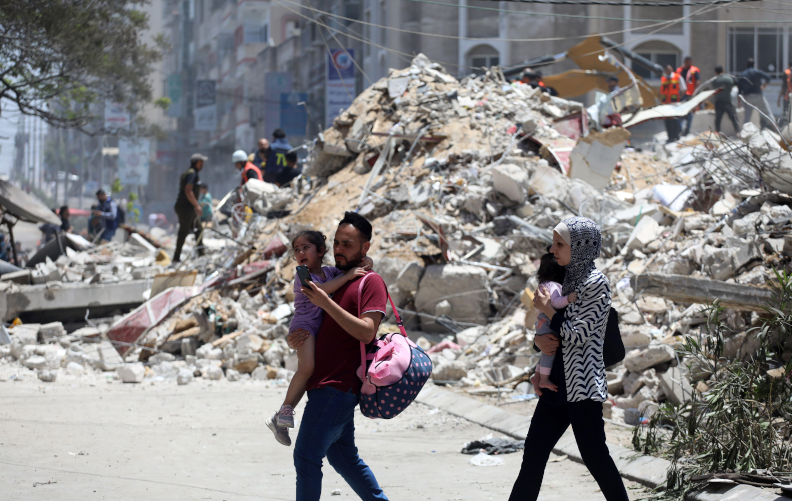While the biblical story of Noah’s Ark is certainly not the only ancient account of a devastating flood (the preceding Sumerian Epic of Gilgamesh, for example, includes a story of the gods sending a great flood on earth), its basic plot of wrath, punishment, ethnic cleansing, and reproductive means of survival provides a compelling framework by which to reflect on Israel’s genocidal efforts in Gaza since at least 7 October 2023.
All citations in this article refer to this document.
Israel has systematically targeted not only Palestinians, but the very reproductive infrastructures — schools, hospitals, municipal buildings, mosques and churches — by which Palestinians stabilise capacities for social, cultural, and economic livelihood. A recent United Nations report published on 13 March 2025, by the Independent International Commission of Inquiry on the Occupied Palestinian Territory, including East Jerusalem and Israel, documents Israel’s targeting of the very capacity of Palestinians to maintain reproductive viability.
Titled “More than a human can bear: Israel’s systematic use of sexual, reproductive and other forms of gender-based violence since 7 October 2023”, the report hinges on the term “reproductive violence”, focussing in the main on Israel’s targeting of women, in respect to their existential and institutional means of fertility.
The 49-page report includes 118 footnotes, carefully sourcing its claims, factual observations, and arguments. At the beginning, it provides a concise explanation of its primary terms of reference: “Reproductive violence is a distinct form of gender-based violence that includes acts or omissions that cause harm by interfering with reproductive autonomy and rights, or violence directed at people because of their actual or perceived reproductive capacity” (4).
Of the almost 50,000 officially recorded Palestinians killed by Israel, 70% are women and children. As the report mentions in regard to the initial onslaught: “During the first month of the war, more than nine out of ten women and children killed were in residential buildings, and 95% of women were killed together with at least one child” (9). However, while noting Israel’s systematic targeting of women, the report outlines how gender-based violence is strategically aimed at the capacity of Palestinians to maintain the means of reproducing themselves.
Besides observing specific incidents of gender-based violence, as well as the wanton decimation of healthcare facilities providing reproductive services, the report documents the fate of a particular fertility clinic, deliberately shelled and destroyed in December 2023. This was the Al-Basma IVF Centre, first established in 1997. It provides services for half of all vitro fertility patients in Gaza, and had stored 4000 embryos. The commission describes Israel’s destruction of the clinic as a crime against fertility rights, noting also Israel’s destruction and blockade of adequate facilities for “pregnancy, childbirth, and postpartum recovery” (45).
In its conclusions, the report argues that Israel’s calculated decimation of fertility and reproductive healthcare amounts “to the crime against humanity of extermination”. To quote its most damning conclusion: “The underlying acts amount to crimes against humanity and deliberately inflicting conditions of life calculated to bring about the physical destruction of Palestinians as a group, one of the categories of genocidal acts in the Rome Statute and the Genocide Convention” (46).
The story of Noah’s Ark is recounted in both the Torah and the Koran. In Arabic, the boat is referred to as safinat Nuha (Noah’s Liner, as safina denotes a vessel much larger than a boat), while in Hebrew it is tevat Noah. The Arabic root saf denotes an assembly, a class, stacking and storing, or else a classification. The Hebrew teva is similar to the Latin arca, a cupboard or chest for storing and safekeeping. Ark, or arkhe, is etymologically linked to archive, meaning the storing of goods and artefacts for reproduction, such as Noah’s Ark – the collection and storage of the means to reproduce human, animal, and vegetal life on earth once the flood has subsided.
The biblical story is relevant in more than one aspect. Firstly, concerning a pathological desire to purify one’s subjects and in the process oneself, through genocide and ethnic cleansing, be rid once and for all of a perceived polluting Other, in the wake of whose destruction arises a purified collective self. Otherwise, the story involves a dramatic narrative by which life and death, living and dying, murder and survival, are dependent on capacities for reproduction, dependent on the means by which a collective, a community, can maintain itself in both life and death, can maintain itself as a historical subject.
Israel’s systematic destruction of the means of Palestinian reproduction, throughout the decades-long Nakba, and especially in its current form of genocidal wrath, involves not only the destruction of Palestinian educational, municipal, health, and religious institutions that house archival resources. It involves also the destruction of rights to life and death. Hence, Israel’s wanton destruction of cemeteries (16 to date) in the Gaza Strip parallels its destruction of embryos and the means of Palestinian fertility.
Cemeteries, places of burial, involve specific practices of ritual and observation, provide reproductive means for heritage, a sort of storing of a community’s capacity to anchor itself in time and place. Life, existential and institutional means for the reproduction of human life, also transpires as a mode of storage, and thus an anchor for Palestinian First Nations people to maintain themselves. While Israel goes about energetically destroying all such anchors, how will Palestinians manage to maintain their rights to life and death, to the historical viability of their ark, in all the sense of this term mentioned above?

Norman Saadi Nikro
Norman Saadi Nikro has Australian and Lebanese backgrounds. He is a former Australian Volunteer Abroad, serving in the West Bank of Palestine in 1998-99. His books include The Fragmenting Force of Memory: Self, Literary Style,and Civil War in Lebanon (2012); Milieus of ReMemory: Relationalities of Violence, Trauma, andVoice (2019); and Nafssiya: Edward Said’s Affective Phenomenology of Racism (2024). Since July 2024 he resides in Sydney as an independent scholar and writer.
